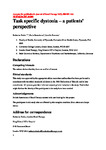Task specific dystonia – a patients’ perspective
| dc.contributor.author | Butler, K | |
| dc.contributor.author | Rosenkranz, K | |
| dc.contributor.author | Freeman, Jennifer | |
| dc.date.accessioned | 2021-08-12T17:28:11Z | |
| dc.date.issued | 2021-04-01 | |
| dc.identifier.issn | 0894-1130 | |
| dc.identifier.issn | 1545-004X | |
| dc.identifier.uri | http://hdl.handle.net/10026.1/17572 | |
| dc.description.abstract |
BACKGROUND: Task specific dystonia (TSD) is a subtype of dystonia with no cure and significant limitations on treatments. Few studies have investigated the outcomes of rehabilitative therapy from the patient's perspective. PURPOSE OF THE STUDY: This study explored the interventions that patients have utilized and their perceived effectiveness in treating and managing their TSD, specifically musicians' dystonia (MD) and writer's dystonia (WD). Symptoms and the effect of TSD on the perceived performance of every day and specific tasks, and possible reasons why the condition developed, were also investigated. STUDY DESIGN: Descriptive survey. METHODS: Patients diagnosed with TSD, treated at a private hand therapy unit, who had consented to being contacted for research purposes, were emailed a link to an online survey (or posted if email was not available), administered via KwikSurveys. The survey consisted of 4 subsections: personal information, general medical history, dystonia medical history and dystonia treatment history. RESULTS: Invitations were sent to 105 patients of whom 90% (n = 95/105) responded. Results for both the MD and WD groups were similar. There was a significant association between the 2 groups as to what they viewed may have led to the development of TSD (a change in technique; P < .001) and the most effective treatments (massage P< .043, modifications to the instrument P< .002; ultrasound therapy P< .013.) All reported that daily activities were affected by their condition. DISCUSSION: Although full levels of task specific function (playing their instrument or writing) were not usually regained, participants with both MD and WD perceived improvement in symptoms with rehabilitation intervention. Three treatments were perceived to be most effective in achieving this, suggesting that these should be considered for inclusion within treatment plans. CONCLUSIONS: From the perspective of people with TSD, a range of rehabilitation interventions are effective in enhancing symptom management, providing further evidence to support their use. | |
| dc.format.extent | 200-207 | |
| dc.format.medium | Print-Electronic | |
| dc.language | en | |
| dc.language.iso | en | |
| dc.publisher | Elsevier BV | |
| dc.subject | Musicians' dystonia | |
| dc.subject | Writers' dystonia | |
| dc.subject | Task specific dystonia | |
| dc.subject | Rehabilitation therapies | |
| dc.subject | Hand therapy | |
| dc.title | Task specific dystonia – a patients’ perspective | |
| dc.type | journal-article | |
| dc.type | Journal Article | |
| plymouth.author-url | https://www.webofscience.com/api/gateway?GWVersion=2&SrcApp=PARTNER_APP&SrcAuth=LinksAMR&KeyUT=WOS:000679951800006&DestLinkType=FullRecord&DestApp=ALL_WOS&UsrCustomerID=11bb513d99f797142bcfeffcc58ea008 | |
| plymouth.issue | 2 | |
| plymouth.volume | 34 | |
| plymouth.publication-status | Published | |
| plymouth.journal | Journal of Hand Therapy | |
| dc.identifier.doi | 10.1016/j.jht.2021.04.005 | |
| plymouth.organisational-group | /Plymouth | |
| plymouth.organisational-group | /Plymouth/Faculty of Health | |
| plymouth.organisational-group | /Plymouth/Faculty of Health/School of Health Professions | |
| plymouth.organisational-group | /Plymouth/REF 2021 Researchers by UoA | |
| plymouth.organisational-group | /Plymouth/REF 2021 Researchers by UoA/UoA03 Allied Health Professions, Dentistry, Nursing and Pharmacy | |
| plymouth.organisational-group | /Plymouth/Research Groups | |
| plymouth.organisational-group | /Plymouth/Research Groups/Institute of Health and Community | |
| plymouth.organisational-group | /Plymouth/Research Groups/Plymouth Institute of Health and Care Research (PIHR) | |
| plymouth.organisational-group | /Plymouth/Users by role | |
| plymouth.organisational-group | /Plymouth/Users by role/Academics | |
| plymouth.organisational-group | /Plymouth/Users by role/Researchers in ResearchFish submission | |
| dc.publisher.place | United States | |
| dcterms.dateAccepted | 2021-04-05 | |
| dc.rights.embargodate | 2022-4-14 | |
| dc.identifier.eissn | 1545-004X | |
| dc.rights.embargoperiod | Not known | |
| rioxxterms.versionofrecord | 10.1016/j.jht.2021.04.005 | |
| rioxxterms.licenseref.uri | http://www.rioxx.net/licenses/all-rights-reserved | |
| rioxxterms.licenseref.startdate | 2021-04-01 | |
| rioxxterms.type | Journal Article/Review |


